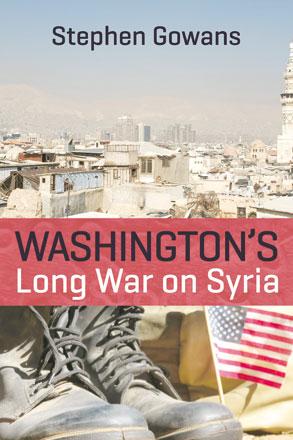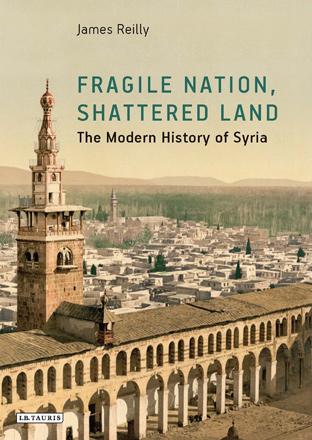You are here
Imperialism versus Arab nationalism
By Sally Bland - May 21,2018 - Last updated at May 21,2018

Washington’s Long War on Syria
Stephen Gowans
Montreal: Baraka Books, 2017
Pp. 278
Combining analysis, polemics and hard facts, Stephen Gowans looks at the war in Syria from an angle not usually presented in the media. Rather than framing it as a popular struggle for democracy against a brutal dictatorship, he identifies it as a conflict rooted in US imperialism’s drive to eliminate all obstacles to its profit-seeking political and economic control.
“The thesis of this book is that Wall Street’s war on Syria was motivated by the same aim [as the war on Iraq]: the de-Baathification of Syria and the elimination of secular Arab nationalist influence from the Syria state, as a means of expunging the Arab nationalist threat to US hegemony…” (p. 21)
Gowans argues convincingly for this thesis by contrasting the contradictory orientations of the US and Syrian state systems. He amasses much evidence showing that US policy, whether domestic or foreign, reflects the interests of the wealthy few rather than the majority of citizens: “Corporate America has the wherewithal to dominate policy formation in Washington, and uses its vast resources to do so. Consequently, US foreign policy reflects a Wall Street agenda.” (p. 209)
This is not just a behind-the-scenes reality. The 2006 National Security Strategy openly stated: “The United States will use military force, unilaterally if necessary… when our livelihoods are at stake”, and Defence Secretary Robert Gates elaborated by saying that the US had a “national interest in… unimpeded economic development and commerce”. (p. 208)
Accordingly, the motivation for seeking regime change in Syria had nothing to do with democracy, especially considering that the majority of US allies in the region are far from democratic. Rather, Arab nationalist, Baathist Syria was targeted for its aspirations of Arab unity which could pool the oil and other resources of the region. Equally, Syria was targeted for its opposition to foreign domination and its state-directed economic development, including protection of local industries.
“Needless to say, the Baathists’ programme was the very antithesis of the model the United States favoured… one of a US-superintended global economy based on free trade, free enterprise, and open markets, overlaid with US political leadership and military domination. It would be naïve to think that Washington was prepared to tolerate an ideology which challenged this paradigm so fundamentally, especially in a region teeming with oil.” (p. 43)
Added to this was the Syrian regime’s alliance with Iran, its opposition to Israeli occupation and expansionism, and its support to Palestinian resistance organisations. While one might object that the regime merely paid lip-service to some of these goals, Gowans assures that US strategists took them seriously.
As early as 1957, the US and Britain charged the CIA’s Middle East chief, Kermit Roosevelt (mastermind of the 1953 coup against Mossadegh who had nationalised Iran’s oil), with assassinating leading figures in the Syrian regime and fomenting an internal uprising with the help of the Muslim Brotherhood. They feared that “Syria’s Baathist-Communist alliance would encourage Mossadegh-like policies throughout the Middle East, and foster popularly-led regime change which would produce pro-independence policies”. (p. 90)
This plan was never carried out as Jordan and Iraq failed to support it, but some of its features reappeared in the 2011 uprising. Evidence exists that the Muslim Brotherhood’s violent campaign against the Syrian regime starting in the 1970s was receiving Western support by the 1980s, and the Bush administration began working with the Brotherhood to topple the regime in 2005, if not earlier. This paved the way for the current CIA programme which by 2015 had trained and equipped nearly 10,000 anti-regime fighters.
The book demolishes a whole slew of myths that have been promoted by the US and other Western governments and media to justify the war on Syria. Chief among them are that the armed opposition was originally democratic and secular, that Bashar Assad’s regime was deeply unpopular, and that it was sectarian, thus pitting “the dominant Alawite minority against the Sunni majority” with little attention paid to the loyalties of other denominations, such as Christians or Druze. “Painting the conflict as a sectarian one also obfuscated the role played by Washington in using mujahedeen as a proxy force to wage war on the Arab nationalists.” (p. 186)
A whole chapter is devoted to countering the myth of the moderate rebel. Another chapter unmasks media bias and Western hypocrisy, with Gowan noting, “We heard endlessly about the use of lethal force to quell internal disturbances in Libya and Syria, and less about the use of the armed power of the state to suppress uprisings in the Arab Gulf kingdoms.” (p. 169)
All in all, this is a fascinating account from a little-aired perspective. Gowan adds depth to his analysis of the workings of imperialism by comparing the Syrian war to what has happened in other countries. While the comparisons to Iraq and Libya are obvious, there are other unexpected international historical references and comparisons to the Russian Revolution, aspects of World Wars I and II, and more. “Washington’s Long War on Syria” is a good example of how historical knowledge can contribute to a better understanding of the present.
Related Articles
Fragile Nation, Shattered Land: The Modern History of SyriaJames A. ReillyBoulder/London: Lynne Reinner Publishers, 2019, Pp.
While 40 years of seldom-interrupted stability under Hafez and Bashar Assad’s rule may make today’s chaos appear as an anomaly
The Merchant of Syria: A History of SurvivalDiana DarkeLondon: Hurst & Company, 2018Pp.














